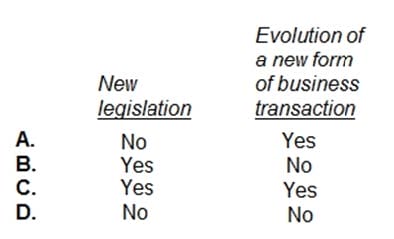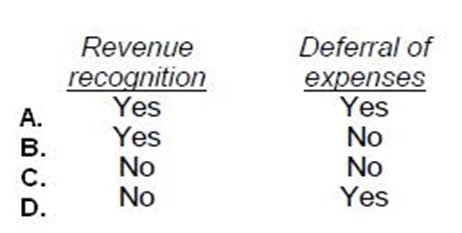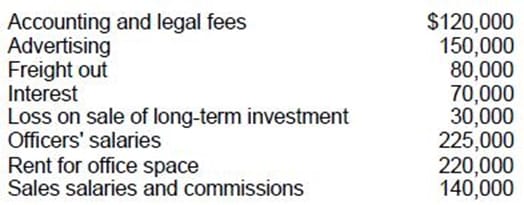CPA-TEST Online Practice Questions and Answers
Which of the following accurately depicts the auditor's responsibility with respect to Statements on Auditing Standards?
A. The auditor is required to follow the guidance provided by the Standards, without exception.
B. The auditor is generally required to follow the guidance provided by Standards with which he or she is familiar, but will not be held responsible for departing from provisions of which he or she was unaware.
C. The auditor is generally required to follow the guidance provided by the Standards, unless following such guidance would result in an audit that is not cost-effective.
D. The auditor is generally required to follow the guidance provided by the Standards, and should be able to justify any departures.
The objective of auditing procedures applied to segment information is to provide the auditor with a reasonable basis for concluding whether:
A. The information is useful for comparing a segment of one enterprise with a similar segment of another enterprise.
B. Sufficient audit evidence has been obtained to allow the auditor to be associated with the segment information.
C. A separate opinion on the segment information is necessary due to inconsistent application of accounting principles.
D. The information is presented in conformity with the FASB Statement on segment information.
According to the profession's ethical standards, which of the following events may justify a departure from a Statement of Financial Accounting Standards?

A. Option A
B. Option B
C. Option C
D. Option D
Tracing shipping documents to prenumbered sales invoices provides evidence that:
A. No duplicate shipments or billings occurred.
B. Shipments to customers were properly invoiced.
C. All goods ordered by customers were shipped.
D. All prenumbered sales invoices were accounted for.
An auditor's program to examine long-term debt should include steps that require:
A. Examining bond trust indentures.
B. Inspecting the accounts payable subsidiary ledger.
C. Investigating credits to the bond interest income account.
D. Verifying the existence of the bondholders.
A limited liability partnership must:
A. File registration documents with the state in which it is formed.
B. Hold all partners personally liable for all debts and liabilities of the partnership and partners.
C. Carry no less than one hundred thousand dollars of property insurance.
D. Not have partners with professional licenses.
Considering the SCOR Model of supply chain operations, which of the following key management processes does implementing changes in engineering fall into?
A. Plan.
B. Source.
C. Make.
D. Deliver.
The Waymand family typically ate hamburger as a regular staple in their diet. In the last few years, the family income has doubled, and they have now replaced hamburger with steak as a regular staple in their diet. This is an example where the demand for hamburger:
A. Is relatively elastic.
B. Is perfectly elastic.
C. Responds as an inferior good.
D. Is perfectly inelastic.
A company has unlimited capital funds to invest. The decision rule for the company to follow in order to maximize shareholders' wealth is to invest in all projects having a(n):
A. Present value greater than zero.
B. Net present value greater than zero.
C. Internal rate of return greater than zero.
D. Accounting rate of return greater than the hurdle rate used in capital budgeting analyses.
Assume the following facts about ABC Corporation:
•
The long-term debt was originally issued at par ($1,000/bond) and is currently trading at $1,250 per bond.
•
ABC Corporation can now issue debt at 150 basis points over U.S. treasury bonds.
•
The current risk-free rate (U.S. treasury bonds) is 7 percent.
•
ABC's common stock is currently selling at $32 per share.
•
The expected market return is currently 15 percent.
•
The beta value for ABC is 1.25.
•
Martin's effective corporate income tax rate is 40 percent.
Based on these assumptions, what is the current net after-tax cost of debt for ABC Corporation?
A. 5.5 percent.
B. 7.0 percent.
C. 5.1 percent.
D. 8.5 percent.
A change in credit policy has caused an increase in sales, an increase in discounts taken, a reduction in the investment in accounts receivable, and a reduction in the number of doubtful accounts. Based upon this information, we know that:
A. Net profit has increased.
B. The average collection period has decreased.
C. Gross profit has declined.
D. The size of the discount offered has decreased.
What is the purpose of information presented in notes to the financial statements?
A. To provide disclosures required by generally accepted accounting principles.
B. To correct improper presentation in the financial statements.
C. To provide recognition of amounts not included in the totals of the financial statements.
D. To present management's responses to auditor comments.
A development stage enterprise should use the same generally accepted accounting principles that apply to established operating enterprises for:

A. Option A
B. Option B
C. Option C
D. Option D
ABC Corp. reports operating expenses in two categories: (1) selling and (2) general and administrative. The adjusted trial balance at December 31, 1989 included the following expense and loss accounts:

One-half of the rented premises is occupied by the sales department. ABC's total selling expenses for 1989 are:
A. $480,000
B. $400,000
C. $370,000
D. $360,000
ABC, Inc. is a multidivisional corporation, which has both intersegment sales and sales to unaffiliated customers. ABC should report segment financial information for each division meeting which of the following criteria?
A. Segment operating profit or loss is 10% or more of consolidated profit or loss.
B. Segment operating profit or loss is 10% or more of combined operating profit or loss of all company segments.
C. Segment revenue is 10% or more of combined revenue of all the company segments.
D. Segment revenue is 10% or more of consolidated revenue.


